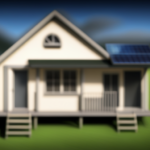Tiny Houses
Master the Micro-Grid: Harnessing Solar Power in Your Tiny House
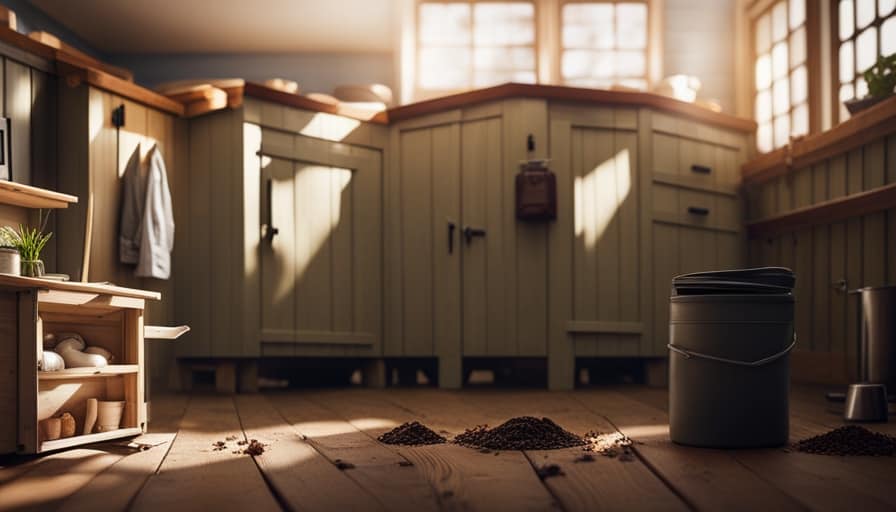
Are you ready to revolutionize your tiny house with solar power? In this article, we, the experts, will guide you through the process of mastering the micro-grid.
From assessing your energy needs to connecting the solar system to house electricity, we will provide you with the technical know-how you need to harness the power of the sun.
Get ready to take control of your energy consumption and serve both your house and the environment.
Let’s dive in!
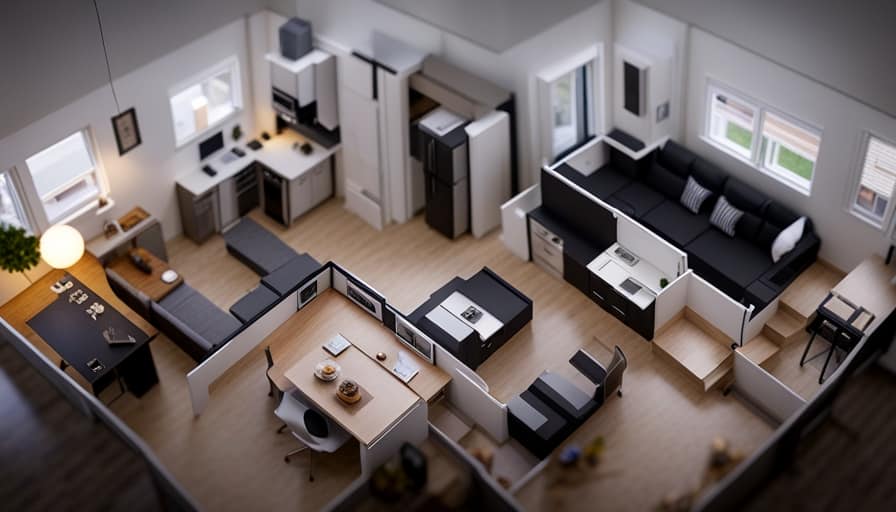
Key Takeaways
- Calculate energy consumption and conduct an inventory of electrical devices to determine total energy load.
- Prioritize energy efficiency by choosing energy-efficient appliances and LED lighting.
- Choose the right solar system considering power requirements, budget, scalability, available space, and maintenance options.
- Source sustainable equipment from reputable suppliers and prioritize eco-friendly equipment procurement.
Assessing Your Energy Needs
We’ll start by determining our energy needs for the tiny house. Calculating our energy consumption is an essential step in designing an efficient and sustainable micro-grid system.
To accurately assess our needs, we must consider various factors such as the number of appliances, their power requirements, and the average daily usage. By conducting an inventory of our electrical devices, we can determine the total energy load. This information will guide us in selecting the appropriate solar panels and battery storage capacity.
In addition to calculating consumption, we must also focus on energy efficiency. Choosing energy-efficient appliances, utilizing LED lighting, and implementing smart energy management systems will help optimize our energy usage. By prioritizing energy efficiency, we can reduce our reliance on the grid and contribute to a greener, more sustainable future.
Choosing the Right Solar System
To ensure optimal energy production, we need to consider our specific power requirements and budget when choosing the right solar system for our tiny house.
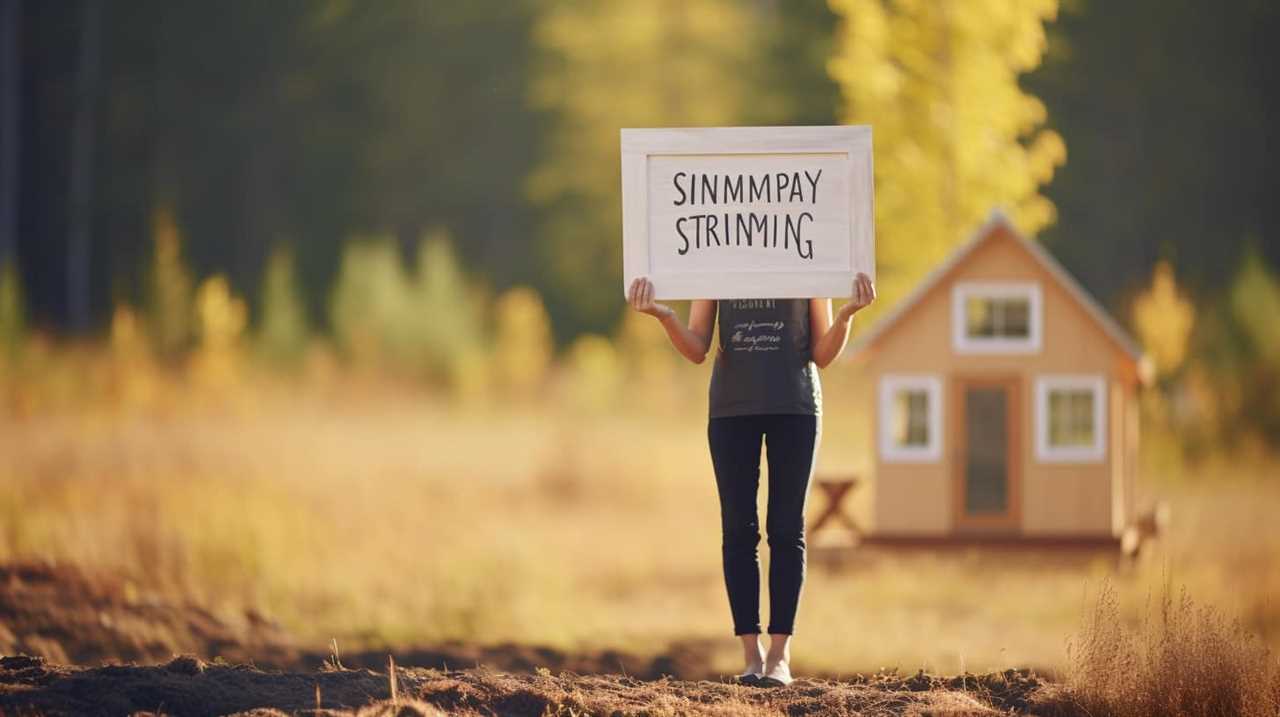
When evaluating costs, we must determine the initial investment as well as the long-term savings. It’s important to consider the scalability of the system, ensuring that it can be expanded in the future if our energy needs increase.
Additionally, we need to assess the available space on our property for solar panels and choose a system that fits within those constraints.
Lastly, we should consider the maintenance and warranty options provided by the solar system manufacturer.
By carefully evaluating these factors, we can select a solar system that meets our needs and budget.
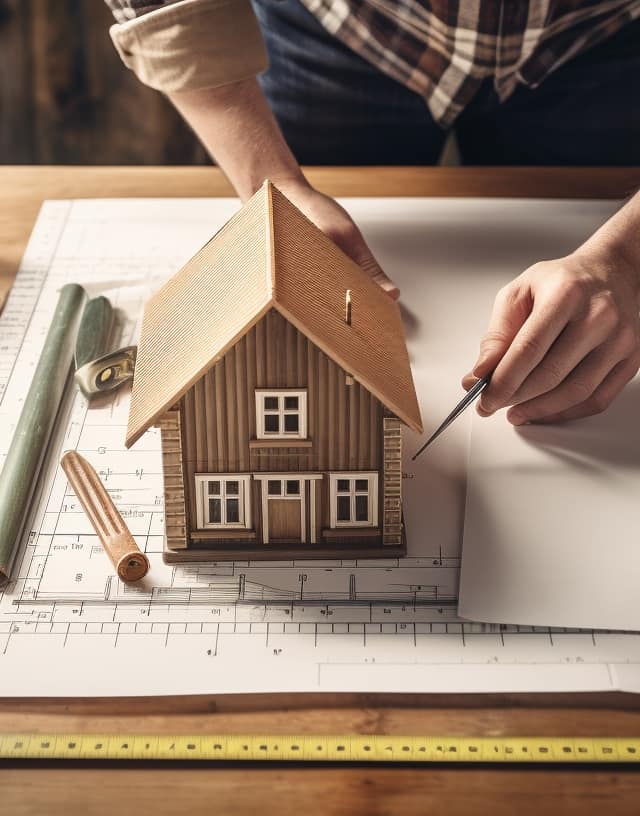
With the right solar system in place, we can move on to procuring the necessary components for our micro-grid setup.
Procuring the Necessary Components
When it comes to setting up a micro-grid in your tiny house, there are several essential components that you’ll need to procure.
These components include:
- Solar panels
- Batteries
- Charge controllers
- Inverters
It’s important to source sustainable equipment that’s designed specifically for off-grid or grid-tied solar systems to ensure optimal performance and efficiency.
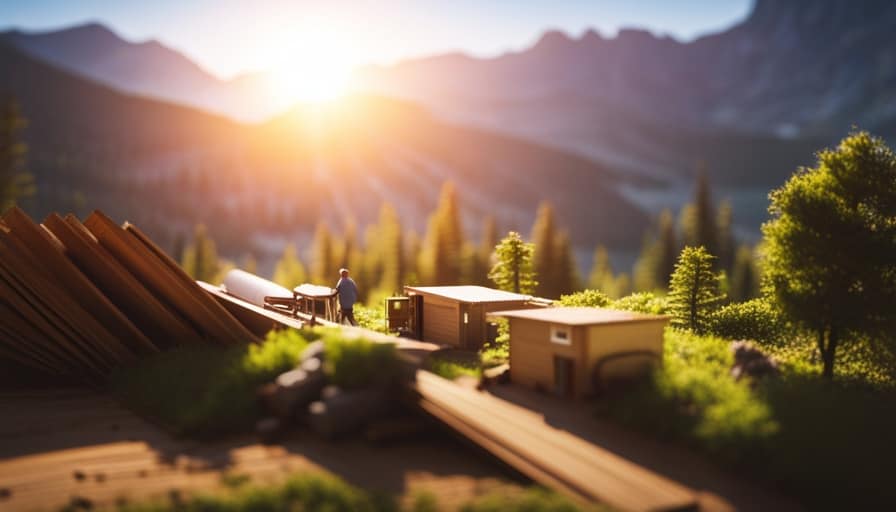
Essential System Components
Let’s start by discussing the key components needed to build a reliable micro-grid system for your tiny house. Here are the essential system components you’ll need to consider:
- Solar Panels: These are the backbone of your micro-grid system, converting sunlight into usable electricity.
- Batteries: To store the excess energy generated by your solar panels, you’ll need a reliable battery bank.
- Inverter: This device converts the direct current (DC) from your solar panels and batteries into alternating current (AC) for your appliances.
- Charge Controller: This component regulates the flow of electricity between your solar panels, batteries, and inverter, ensuring optimal charging and preventing overcharging.
Assessing the energy efficiency and integrating renewable sources are key steps in building a sustainable micro-grid system.
Now that we understand the essential components, let’s move on to the next section: sourcing sustainable equipment.
Sourcing Sustainable Equipment
We recommend starting with two key steps: researching reputable suppliers and comparing prices when sourcing sustainable equipment for your micro-grid. It’s important to prioritize eco-friendly equipment procurement to ensure that your tiny house operates efficiently and in harmony with the environment.
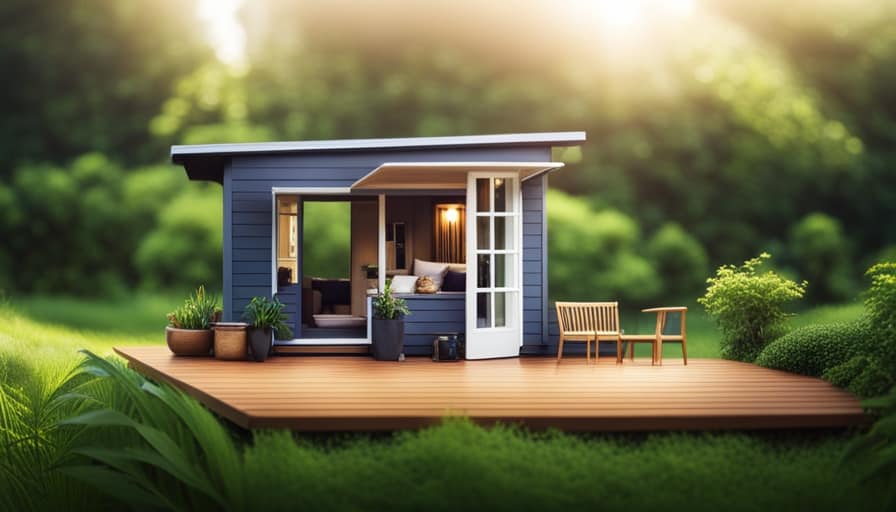
Look for suppliers who specialize in sustainable energy solutions and offer a wide range of products to meet your specific needs. Consider factors such as the durability, efficiency, and lifespan of the equipment before making your final decision. Additionally, comparing prices will help you find the best deal without compromising on quality.
Once you have procured the necessary components, the next step is to position the solar panels effectively to maximize their exposure to sunlight and optimize energy generation.
Positioning the Solar Panels Effectively
When it comes to positioning solar panels effectively, there are a few key points to consider.
First, optimal panel placement is crucial for maximizing solar energy absorption. This means positioning the panels in a location that receives the most sunlight throughout the day.
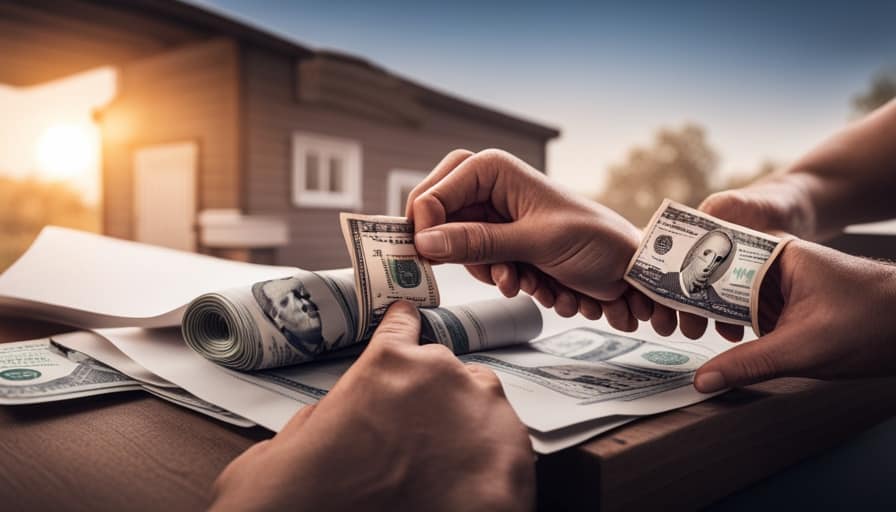
Additionally, considering factors such as shading from nearby trees or buildings can help ensure that the panels are able to capture as much sunlight as possible.
Optimal Panel Placement
To ensure maximum efficiency, place the solar panels in a way that allows for optimal sunlight exposure throughout the day. Here are some key factors to consider when positioning your solar panels:
-
Orientation: Position the panels facing south in the Northern Hemisphere or north in the Southern Hemisphere to receive the most sunlight.
-
Tilt angle: Adjust the tilt angle of the panels based on your location’s latitude to maximize their exposure to the sun.
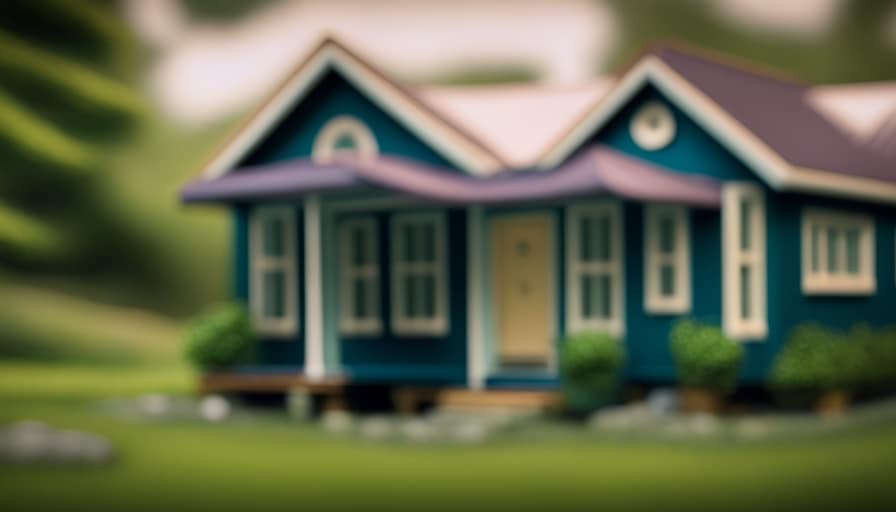
-
Shading: Avoid any potential shading from nearby objects like trees or buildings, as it can significantly reduce the panels’ performance.
-
Solar tracking: Consider using solar tracking systems that automatically adjust the position of the panels throughout the day to follow the sun’s path.
Maximizing Solar Energy
Let’s ensure we position our solar panels strategically to maximize solar energy production in our tiny house. Maximizing efficiency is crucial to make the most of the limited space available on our rooftop.
First, consider the orientation of the panels. Ideally, they should face south to receive maximum sunlight throughout the day. Additionally, the tilt angle should be adjusted according to our latitude to optimize energy absorption.

Regular solar panel maintenance is also essential for optimal performance. Keep the panels clean and free from debris, as dirt or dust can reduce their efficiency. Inspect the panels regularly for any damage or shading caused by nearby objects.
Wiring the Solar System
How can we efficiently wire the solar system in our tiny house to maximize power generation and utilization?
-
Start by mapping out the electrical layout: Identify the key components such as solar panels, charge controllers, batteries, and inverters, and plan their placement accordingly.
-
Use appropriate wire gauge: To minimize power loss and ensure safety, choose the right wire gauge for each component based on the distance and current requirements.
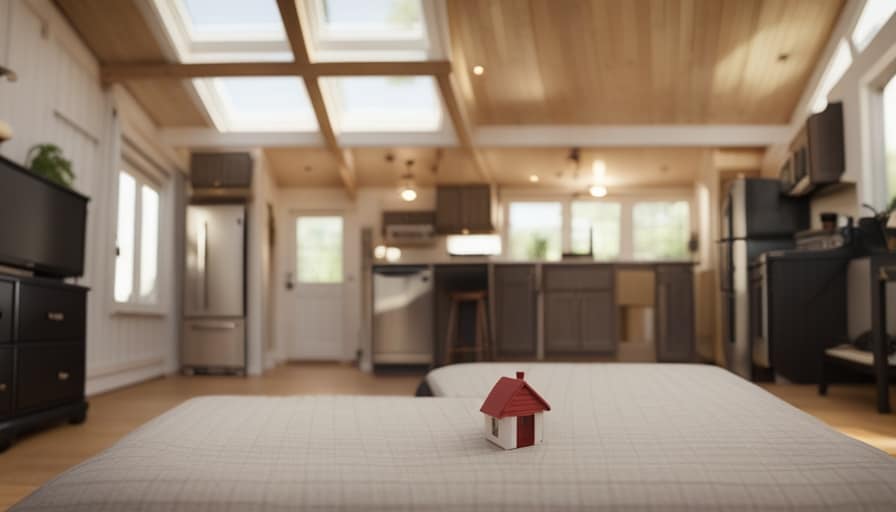
-
Implement proper grounding: Grounding is crucial to protect against electrical faults and ensure the system operates smoothly. Follow the National Electrical Code guidelines for grounding.
-
Label and document all connections: Proper labeling and documentation of connections will make it easier for future solar system maintenance and troubleshooting common issues.
Installing the Inverter
With careful planning and proper placement, we can easily install the inverter in our tiny house solar system. The inverter is an essential component that converts the direct current (DC) electricity produced by the solar panels into alternating current (AC) electricity that can power our appliances. When installing the inverter, it is important to consider a few troubleshooting tips. Firstly, ensure that the inverter is properly grounded to avoid electrical hazards. Additionally, double-check the connections to ensure they are secure and tight. Understanding inverter efficiency is also crucial. Efficiency refers to how well the inverter converts the DC electricity into AC electricity. Look for inverters with high efficiency ratings, as this will maximize the energy output of our solar system. Consider the following table for a comparison of different inverter options:
| Inverter Model | Efficiency Rating |
|---|---|
| Model A | 95% |
| Model B | 98% |
| Model C | 92% |
Setting Up the Battery System
We can start by connecting the batteries in parallel using a series of cables and a coordinating junction box. This setup helps to increase the battery bank’s capacity and provide a more reliable power supply for your tiny house.

When it comes to battery maintenance, there are a few key things to keep in mind. Regularly check the battery voltage and electrolyte levels to ensure they’re within the recommended range. Clean the battery terminals and connections to prevent corrosion and ensure a good electrical connection. It’s also important to avoid overcharging or deep discharging the batteries, as this can significantly reduce their lifespan.
Proper maintenance will help maximize the battery lifespan and ensure reliable power for your tiny house.
Now, let’s move on to connecting the solar system to house electricity.
Connecting the Solar System to House Electricity
To ensure a seamless integration of solar power into our tiny house, we need to connect the solar system to the house electricity using a reliable and efficient method. One way to achieve this is by connecting the solar panels to the grid. This allows any excess power generated by the solar panels to be sent back to the grid, effectively reducing our reliance on traditional electricity sources.
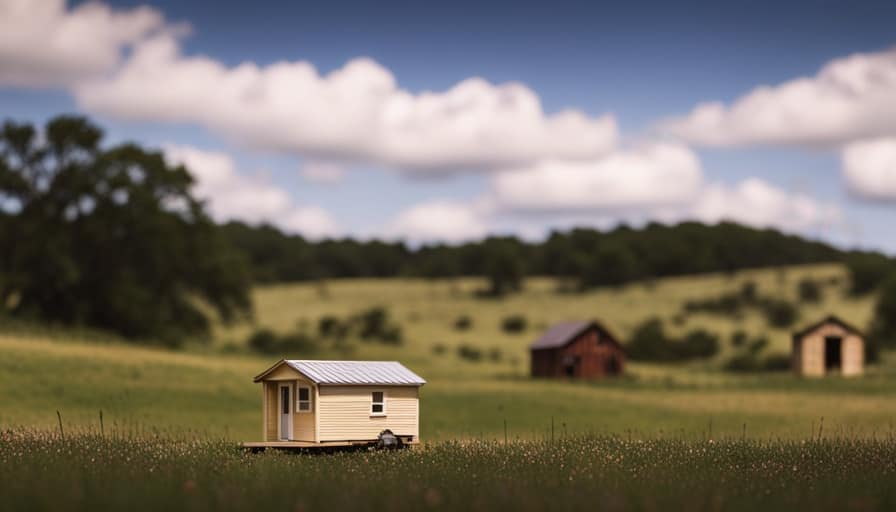
Integrating solar power into an existing electrical system requires some additional components. We’ll need an inverter, which converts the direct current (DC) power generated by the solar panels into alternating current (AC) power that can be used in our household appliances. Additionally, a charge controller is necessary to regulate the flow of electricity between the solar panels and the batteries, ensuring optimal charging and preventing overcharging.
Testing and Regular Maintenance of the Micro-Grid
Regular maintenance of the micro-grid is essential to ensure its optimal performance and longevity. To keep your micro-grid running smoothly, it’s important to follow a regular maintenance schedule and conduct testing procedures. Here are some key steps to include in your maintenance routine:
- Conduct regular inspections of all components, including solar panels, batteries, and inverters, to identify any signs of wear or damage.
- Clean the solar panels regularly to remove dirt and debris that can reduce their efficiency.
- Test the battery performance and voltage levels to ensure they’re functioning properly.
- Check the connections and wiring to ensure there are no loose or damaged parts that could disrupt the flow of electricity.
Frequently Asked Questions
How Long Will It Take for a Solar System to Pay for Itself in Terms of Cost Savings on Energy Bills?
Estimating the return on investment for a solar system in a tiny house depends on several factors. These include the cost of the system, energy usage, and local utility rates. It typically takes several years for the system to pay for itself through energy bill savings.
Can I Still Connect to the Grid and Sell Excess Energy Back to the Utility Company?
Yes, we can still connect to the grid and sell excess energy back to the utility company. However, there are limitations such as grid connection fees and regulations that vary depending on location.
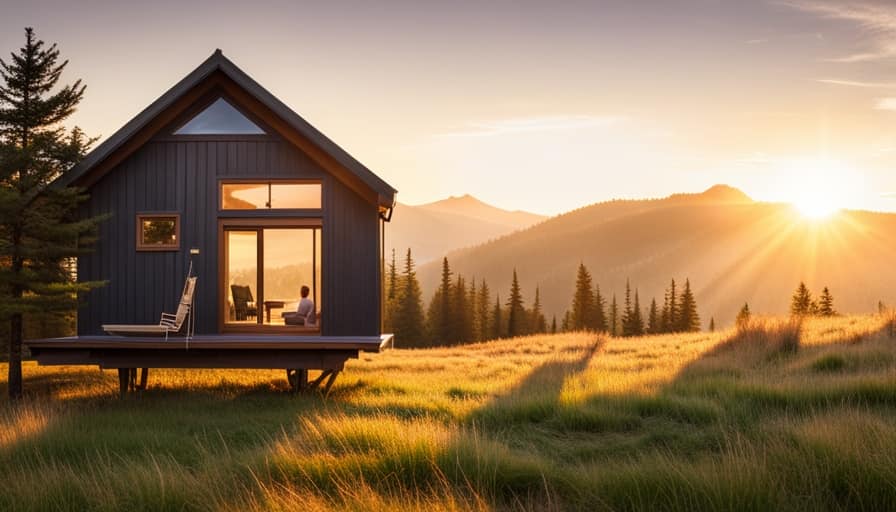
Are There Any Government Incentives or Tax Credits Available for Installing a Solar System in a Tiny House?
Yes, there are government incentives and tax credits available for installing a solar system in a tiny house. These incentives and credits can help offset the cost and make solar power more affordable.
What Kind of Maintenance Is Required for the Solar Panels and Other Components of the Micro-Grid System?
Solar panel maintenance is essential for optimal performance. Regular cleaning and inspection of components ensure longevity and efficiency. We must prioritize proper upkeep to ensure a reliable micro-grid system in our tiny house.
Can I Expand My Solar System in the Future if I Want to Increase My Energy Production Capacity?
Yes, we can expand our solar system in the future to increase our energy production capacity. This allows us to meet our growing energy needs and take advantage of advancements in solar technology.
Conclusion
In conclusion, mastering the micro-grid and harnessing solar power in your tiny house is like becoming the captain of your own ship. By assessing your energy needs, choosing the right solar system, and procuring the necessary components, you can navigate the seas of renewable energy.
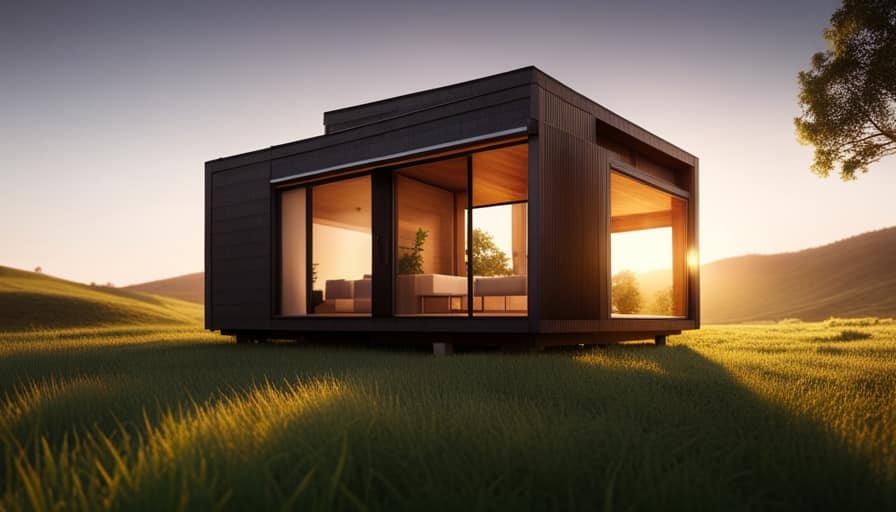
Positioning the solar panels effectively, wiring the system, and setting up the battery system are like hoisting the sails and steering your ship towards a sustainable future.
With regular maintenance, you can keep your micro-grid shipshape and enjoy the benefits of clean, renewable energy.
I’m Theodore, and I love tiny houses. In fact, I’m the author of Tiny House 43, a book about tiny houses that are also tree houses. I think they’re magical places where imaginations can run wild and adventures are just waiting to happen.
While tree houses are often associated with childhood, they can be the perfect adult retreat. They offer a cozy space to relax and unwind, surrounded by nature. And since they’re typically built on stilts or raised platforms, they offer stunning views that traditional homes simply can’t match.
If you’re looking for a unique and romantic getaway, a tree house tiny house might just be the perfect option.
Tiny Houses on Wheels
How Do Gou Prevent Stealing of a Tiny House on Wheels
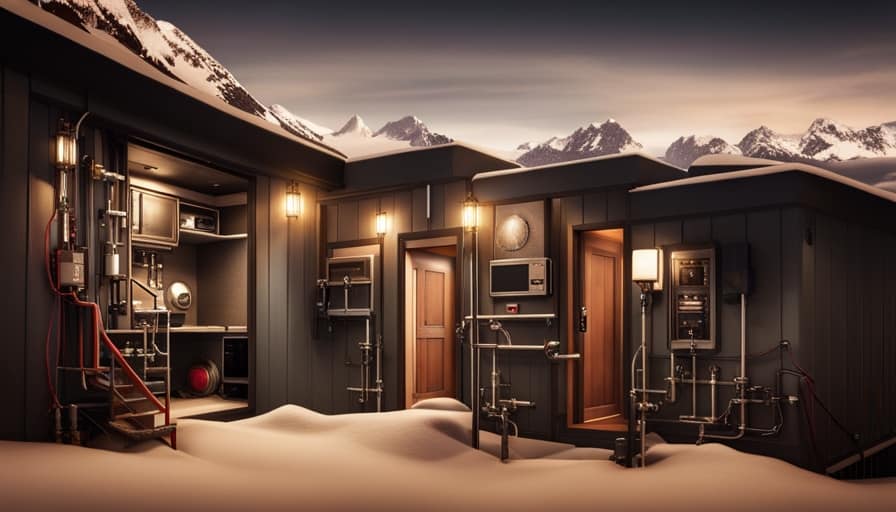
As a person who places a high priority on ensuring the safety of my small mobile home, I recognize the significance of deterring theft.
In this article, I will explore effective strategies to safeguard your mobile home from potential thefts.
By assessing vulnerabilities, implementing advanced security systems, strengthening physical barriers, utilizing surveillance technology, and establishing community watch programs, we can create a safe and secure environment for our tiny homes.
Let’s delve into practical solutions that will help protect our cherished dwellings.
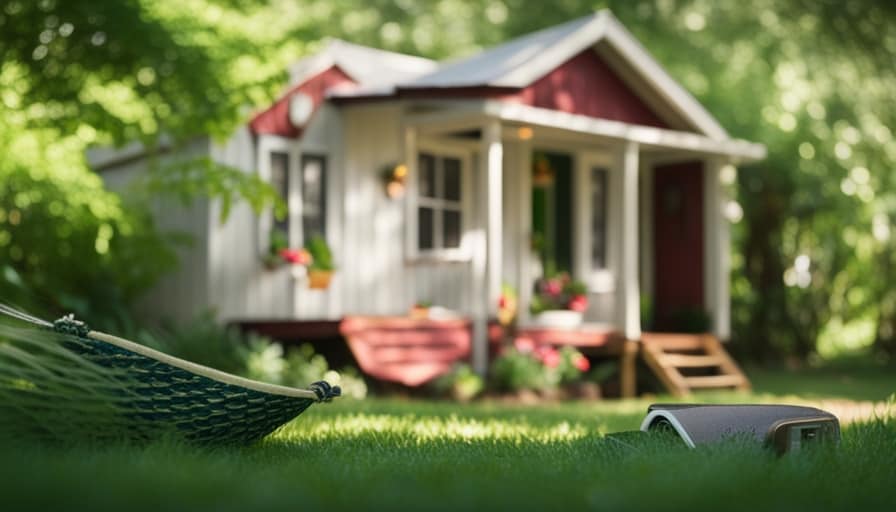
Key Takeaways
- Assess vulnerabilities and weak points in the tiny house, such as doors, windows, and structural integrity.
- Implement advanced security systems like biometric access control, geofencing technology, surveillance cameras, and robust alarm systems.
- Strengthen physical barriers and locking mechanisms with sturdy doors, reinforced frames, window security film, and window bars or grilles.
- Utilize surveillance technology, alarms, and GPS tracking devices to enhance security and monitor the tiny house remotely.
Assessing Vulnerabilities and Weak Points
What are the potential vulnerabilities and weak points that I need to assess in order to prevent the stealing of my tiny house on wheels?
When it comes to securing my mobile home, I must start by assessing the entry points and evaluating the structural integrity. First, I need to check the doors and windows for any signs of weakness or easy access points. Are the locks sturdy and reliable? Are there any gaps or cracks that could be exploited?
Next, I should examine the overall structure of the tiny house. Are there any areas that seem vulnerable to break-ins or damage? By thoroughly assessing these vulnerabilities and weak points, I can take the necessary steps to reinforce and protect my tiny house on wheels.
With this in mind, let’s now move on to implementing advanced security systems to further enhance its safety and security.

Implementing Advanced Security Systems
I can enhance the safety and security of my tiny house on wheels by installing advanced security systems. Here are some options to consider:
-
Biometric Access Control: This technology allows me to use my unique fingerprint or other biometric data to control access to my tiny house. It adds an extra layer of security by ensuring only authorized individuals can enter.
-
Geofencing Technology: By setting up a geofence around my tiny house, I can receive alerts whenever it’s moved beyond a specific boundary. This allows me to quickly respond and take appropriate action if someone tries to steal my house.
-
Surveillance Cameras: Installing high-quality surveillance cameras around my tiny house will deter potential thieves and provide evidence in case of a theft. I can also access the camera feed remotely to monitor the security of my house.

-
Alarm System: A robust alarm system with sensors on doors and windows will sound an alarm if someone tries to break in. This will alert me and potentially scare off the intruder.
Strengthening Physical Barriers and Locking Mechanisms
To further enhance the security of my tiny house on wheels, I can reinforce physical barriers and utilize strong locking mechanisms. By doing so, I can effectively deter potential thieves and protect my valuable belongings. One way to reinforce the entry points is by installing sturdy doors with multiple deadbolt locks. Additionally, reinforcing the door frames with steel plates can make it more difficult for intruders to break in. Another important aspect to consider is securing the windows. Installing window security film can make it harder for burglars to shatter the glass and gain access. Adding window bars or grilles can provide an extra layer of protection. By implementing these measures, I can significantly reduce the risk of theft and ensure the safety of my tiny house on wheels.
| Reinforcing Entry Points | Securing Windows |
|---|---|
| Sturdy doors with multiple deadbolt locks | Window security film |
| Reinforced door frames with steel plates | Window bars or grilles |
Utilizing Surveillance Technology and Alarms
I frequently utilize surveillance technology and alarms to enhance the security of my tiny house on wheels. Here are some ways I use these tools to keep my home safe:
-
Remote Monitoring: I install security cameras that allow me to monitor my tiny house from anywhere. This way, I can keep an eye on it even when I’m not around.

-
Alarms: I’ve an alarm system installed that immediately alerts me if there’s any unauthorized entry or movement detected in and around my tiny house.
-
GPS Tracking: To further protect my house, I use GPS tracking devices. These devices allow me to track the location of my tiny house at all times, making it easier to recover it if it gets stolen.
-
Smart Home Integration: I integrate my surveillance technology and alarms with smart home devices. This allows me to control and monitor everything from my phone, making security management more convenient.
Establishing a Community Watch and Neighborhood Security Measures
Regularly engaging in community watch and implementing neighborhood security measures can significantly deter theft of a tiny house on wheels. Building trust within the community is crucial in fostering a sense of community and cooperation.
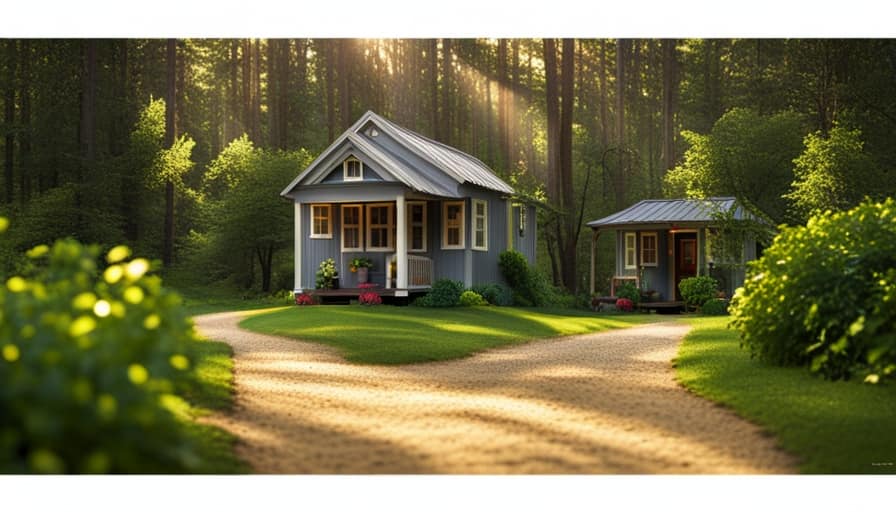
By organizing regular neighborhood meetings and events, residents can get to know each other and establish a network of support. This not only creates a stronger bond among neighbors but also increases the chances of spotting suspicious activities and preventing theft.
Educating residents about the importance of security and promoting awareness and prevention techniques is also essential. Sharing tips on securing the tiny house, such as installing locks, alarms, and motion-sensor lights, can go a long way in deterring potential thieves.
Frequently Asked Questions
Are There Any Legal Requirements or Permits Needed to Install Advanced Security Systems in a Tiny House on Wheels?
To install advanced security systems in a tiny house on wheels, it’s important to consider permits, regulations, and legal requirements. Additionally, explore insurance options and consider installing a GPS tracking device. By avoiding common mistakes, you can better protect your tiny house.
How Can I Ensure That My Tiny House on Wheels Is Protected Against Theft While I Am Away on Vacation?
While on vacation, I ensure the security of my tiny house on wheels by implementing various measures. This includes installing home surveillance systems, using sturdy locks, and parking in well-lit areas.
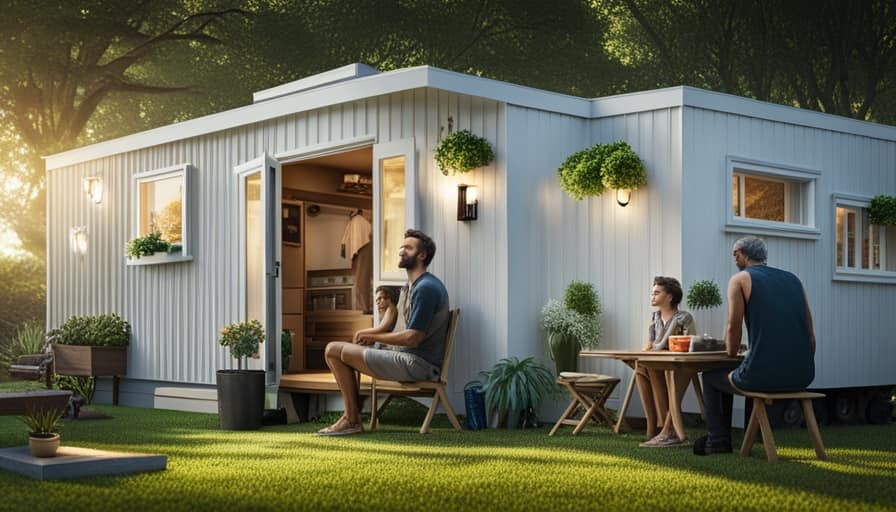
Are There Any Insurance Options Available Specifically for Tiny Houses on Wheels to Cover Theft or Break-Ins?
There are insurance options available for tiny houses on wheels that can cover theft or break-ins. It’s important to research and compare different policies to find the best coverage for your specific security system requirements.
Can I Install a GPS Tracking Device on My Tiny House on Wheels to Locate It in Case of Theft?
Yes, I can install a GPS tracking device on my tiny house on wheels to locate it in case of theft. Additionally, I can enhance security by installing security cameras and hiring a professional security service.
What Are Some Common Mistakes People Make When Trying to Secure Their Tiny Houses on Wheels and How Can I Avoid Them?
Common mistakes when securing a tiny house on wheels include relying solely on a GPS tracker, neglecting to reinforce doors and windows, and forgetting to install a robust security system. To prevent theft, I can avoid these errors by implementing multiple layers of security measures.
Conclusion
After assessing vulnerabilities, implementing advanced security systems, and strengthening physical barriers, stealing a tiny house on wheels can be significantly prevented. Utilizing surveillance technology and establishing a community watch are also effective measures.

By taking these proactive measures, we can ensure the safety and security of our homes. So, let’s lock up and leave worries behind, knowing that our tiny houses are protected and poised for peaceful living.
I’m Theodore, and I love tiny houses. In fact, I’m the author of Tiny House 43, a book about tiny houses that are also tree houses. I think they’re magical places where imaginations can run wild and adventures are just waiting to happen.
While tree houses are often associated with childhood, they can be the perfect adult retreat. They offer a cozy space to relax and unwind, surrounded by nature. And since they’re typically built on stilts or raised platforms, they offer stunning views that traditional homes simply can’t match.
If you’re looking for a unique and romantic getaway, a tree house tiny house might just be the perfect option.
Luxurious Tiny House
Living Large in Minimal Spaces: A Guide to Luxe Tiny House Living

Are you prepared to appreciate the beauty of living large in small spaces? Our guide to luxurious tiny house living has everything you need.
Imagine transforming a 300 square foot space into a luxurious oasis. With smart design, efficient organization, and a touch of creativity, you can create a home that feels spacious, elegant, and truly yours.
Get ready for a journey of innovation and inspiration as we show you how to make the most of every square inch.
Key Takeaways
- Utilize clever storage solutions and multifunctional furniture to maximize space and storage in a tiny house.
- Choose the right lighting fixtures and incorporate indoor plants to create a luxurious ambiance in a small space.
- Incorporate stylish and functional design elements such as compact appliances and space-saving storage solutions.
- Maximize outdoor space and entertainment by incorporating foldable furniture, outdoor seating, and entertainment options like outdoor movie nights or a DIY outdoor kitchen.
Maximizing Limited Space
We can make the most of our limited space by utilizing clever storage solutions and multifunctional furniture.
In our quest for maximizing storage, we must think creatively when it comes to space utilization. One innovative idea is to utilize vertical space by installing high shelves or hanging organizers. This not only frees up valuable floor space but also adds visual interest to the room.
Another suggestion is to invest in furniture that serves multiple purposes. For example, a sofa with built-in storage compartments or a coffee table that can be extended into a dining table. These space-saving solutions allow us to have all the functionality we need without sacrificing style or comfort.
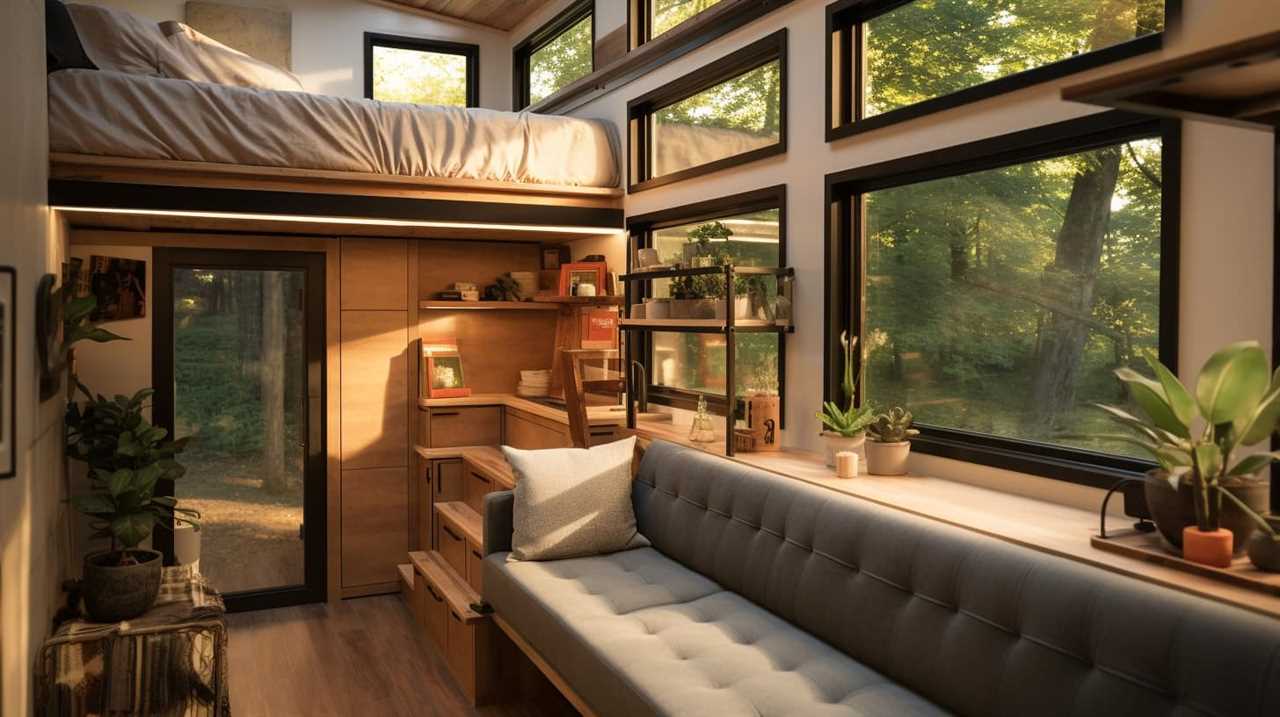
Now, let’s transition into the subsequent section about effective belongings organization, where we’ll explore practical tips for keeping our tiny homes clutter-free.
Effective Belongings Organization
Let’s start by implementing smart storage solutions to efficiently organize our belongings in our tiny homes.
In order to make the most of our limited space, it’s important to declutter and streamline our possessions. One effective decluttering technique is to categorize our belongings into three main categories: keep, donate/sell, and discard. By doing this, we can easily identify what items are essential and what can be let go.
Once we’ve narrowed down our belongings, it’s time to find efficient storage solutions. Utilizing vertical space, such as wall-mounted shelves or overhead storage, can help maximize storage options. Additionally, investing in multi-functional furniture, like ottomans with hidden storage or bed frames with built-in drawers, can provide extra space for our belongings.
Creating Luxurious Ambiance With Lighting
One of the key elements in creating a luxurious ambiance in our tiny homes is choosing the right lighting fixtures. Lighting can transform a small space into a cozy oasis, adding warmth and sophistication.
Here are three ambient lighting techniques to help you create a cozy atmosphere in your tiny home:
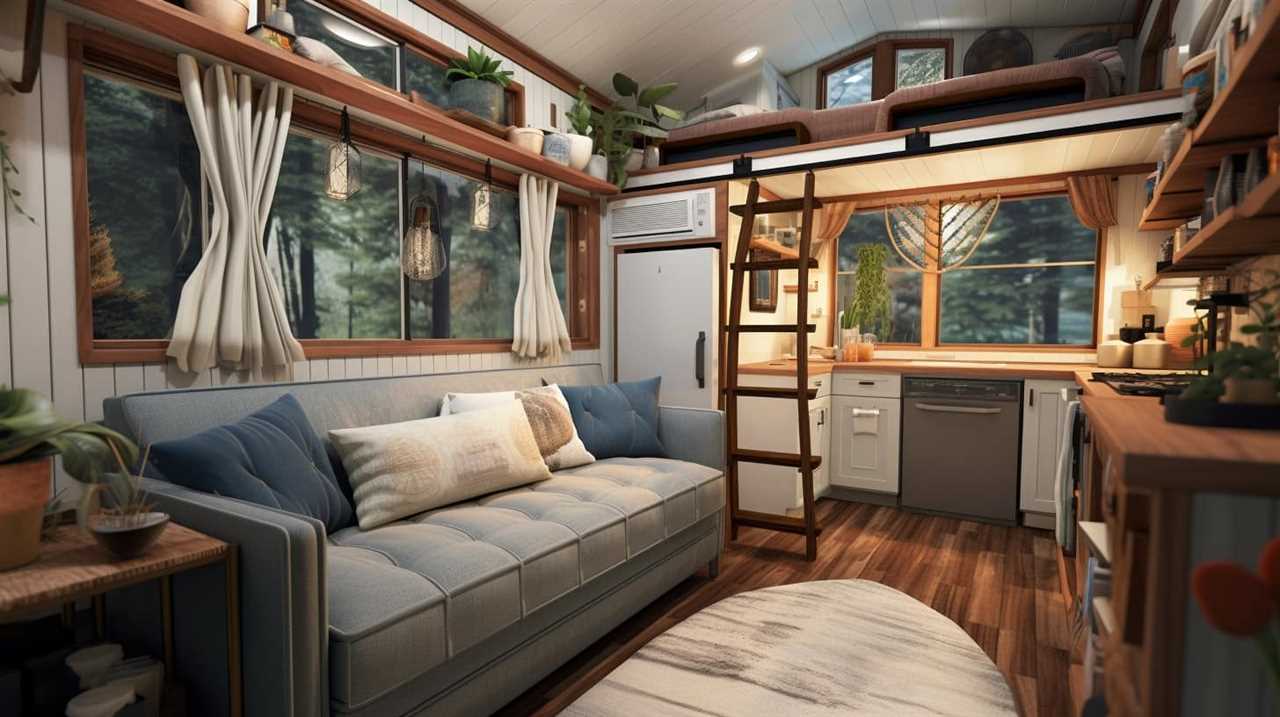
-
Soft, warm lighting: Use warm-toned bulbs or dimmers to create a soft glow in your space. This type of lighting is perfect for creating a cozy and inviting atmosphere.
-
Strategic placement: Consider placing lighting fixtures in different areas of your tiny home to create depth and enhance the overall ambiance. Use wall sconces, fairy lights, or pendant lights to add visual interest and create a luxurious feel.
-
Accent lighting: Highlight specific areas or objects in your tiny home with accent lighting. This technique can draw attention to artwork, architectural features, or decorative elements, adding a touch of elegance and sophistication.
Maintaining Cleanliness in Small Spaces
When it comes to maintaining cleanliness in small spaces, we need to get creative with our cleaning methods. Space-saving cleaning hacks allow us to maximize the limited area we have, while still keeping everything spotless.
In addition, minimalist cleaning essentials help us streamline our cleaning routine and prevent clutter from taking over our tiny house.
Space-Saving Cleaning Hacks
We love finding space-saving cleaning hacks to maintain cleanliness in our small living spaces. Living in a tiny house means that every inch of space is valuable, so finding creative ways to store cleaning supplies is essential.
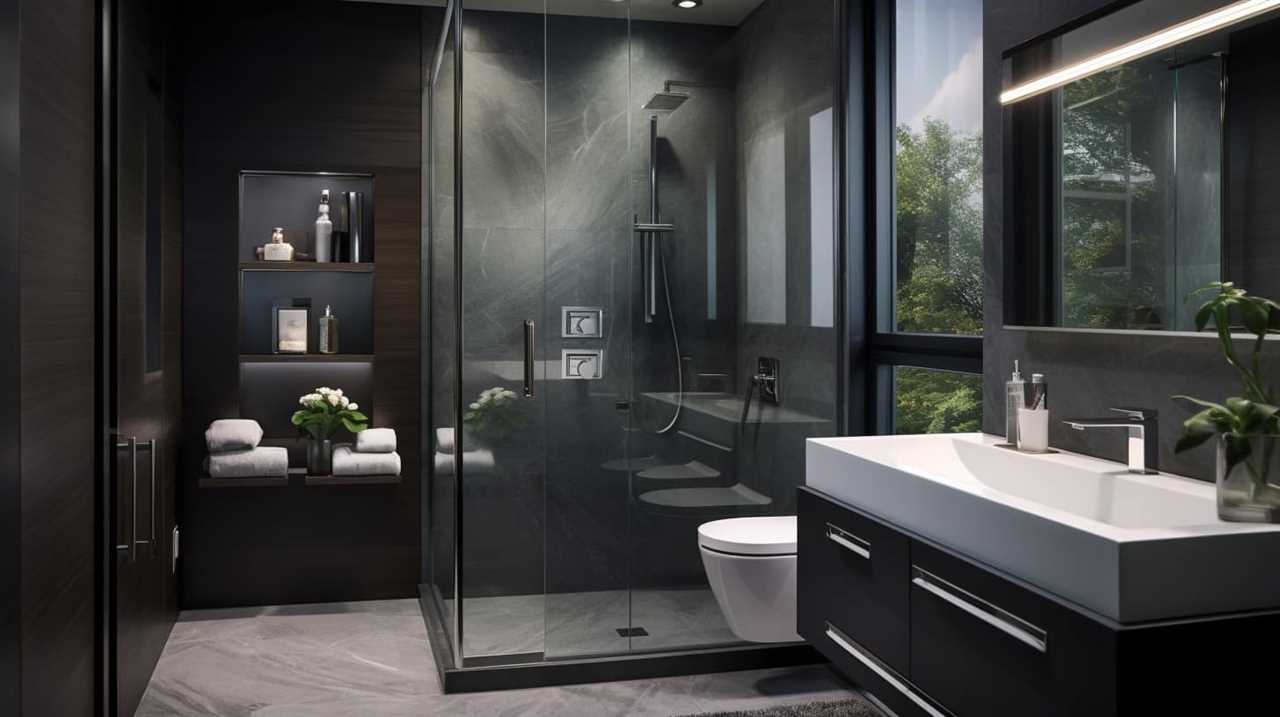
Here are three space-saving storage ideas for your cleaning essentials:
-
Over-the-door organizer: Hang an over-the-door shoe organizer on the inside of a closet door or bathroom door. Use the pockets to store cleaning sprays, microfiber cloths, and small brushes. This keeps them easily accessible and frees up valuable cabinet or closet space.
-
Wall-mounted broom holder: Install a wall-mounted broom holder in your utility closet or laundry area. This will keep your brooms, mops, and dusters neatly organized and off the floor. It’s a great way to utilize vertical space and keep your cleaning tools within reach.
-
Stackable storage bins: Invest in stackable storage bins with lids. These can be used to store cleaning products under the sink, in the bathroom, or in a closet. The bins will keep everything organized and prevent spills or leaks. Plus, they can be neatly stacked to maximize space.
Minimalist Cleaning Essentials
We frequently prioritize minimalist cleaning essentials to maintain cleanliness in our small living spaces. By using effective cleaning techniques and minimalist cleaning products, we can keep our tiny homes spotless without cluttering our limited storage space. Here are some essential cleaning products that are both efficient and compact:
| Product | Purpose |
|---|---|
| Microfiber cloths | Ideal for dusting and wiping surfaces |
| All-purpose cleaner | Versatile and effective for multiple cleaning tasks |
| Baking soda | A natural and gentle abrasive for scrubbing stains |
With these minimalist cleaning essentials, we can tackle any mess in our tiny homes while keeping our cleaning supplies to a minimum. Maintaining cleanliness in our small spaces allows us to fully enjoy the beauty and functionality of our luxurious tiny houses. Now, let’s transition into the next section where we explore how to add elegance through indoor plant cultivation.
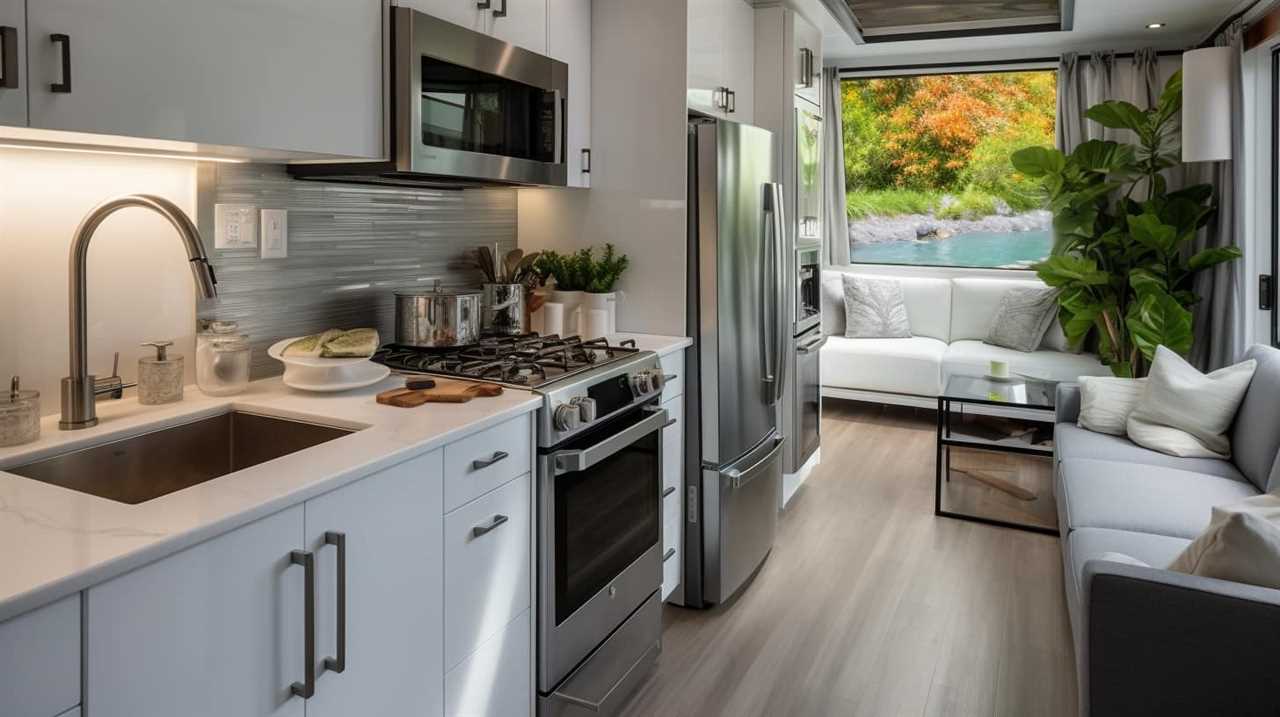
Elegance Through Indoor Plant Cultivation
As we explore the concept of elegance through indoor plant cultivation, it becomes evident that incorporating greenery into small living spaces can create a luxurious and refreshing ambiance. Indoor herb gardening is a popular trend that brings the beauty and benefits of nature indoors.
Here are three ways to incorporate natural elements into your tiny house:
-
Vertical Gardens: Utilize vertical space by installing wall-mounted planters or hanging baskets. This not only adds a touch of elegance to your space but also maximizes the use of limited floor space.
-
Miniature Terrariums: Create your own tiny ecosystem with miniature terrariums. These self-contained glass containers filled with plants and moss bring a sense of serenity and tranquility to your living area.
-
Window Sill Gardens: Make use of your windowsill by creating a mini garden filled with herbs and small plants. This not only provides easy access to fresh herbs for cooking but also adds a vibrant and lush aesthetic to your space.
Incorporating natural elements through indoor plant cultivation adds a touch of elegance and serenity to your tiny house, creating a luxurious and refreshing ambiance.
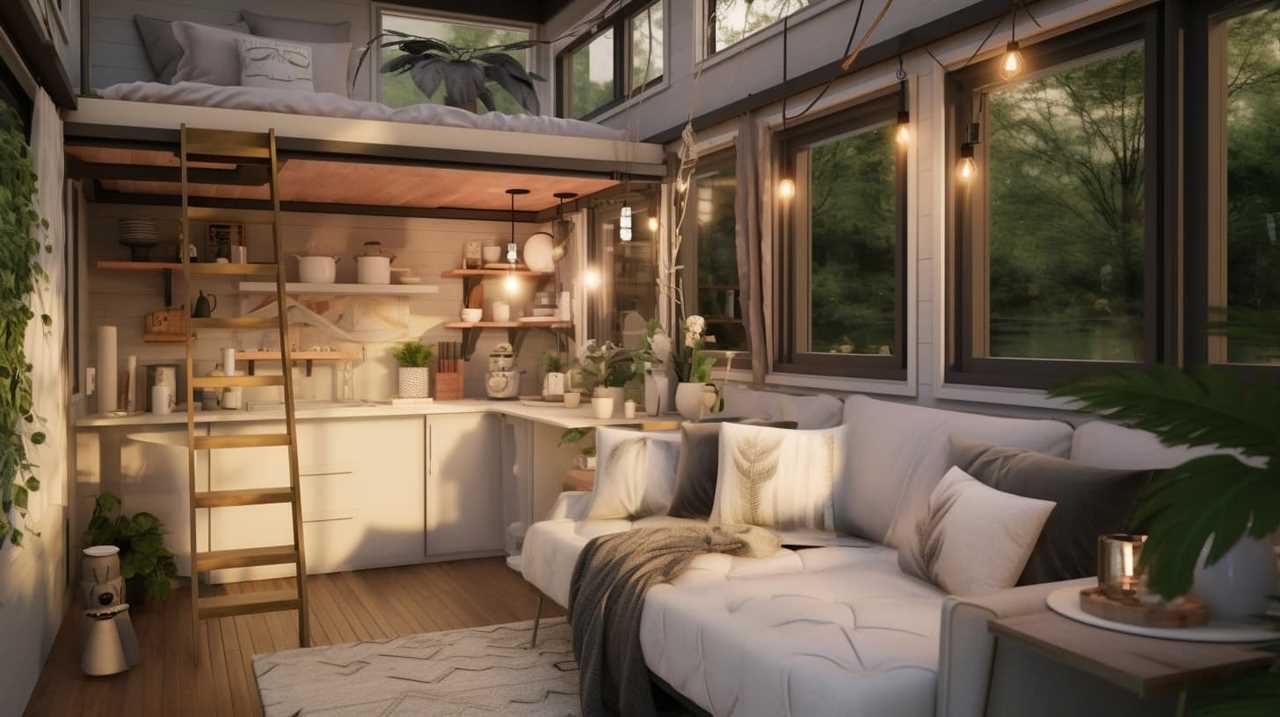
Choosing Multifunctional Furniture
The key to maximizing space in our tiny house is selecting multifunctional furniture that serves multiple purposes and saves valuable square footage.
One of the best ways to achieve this is by choosing furniture with hidden storage compartments. For example, our coffee table not only provides a surface for drinks and snacks, but also opens up to reveal ample storage space for books, magazines, and board games.
Our sofa is another versatile piece, with built-in drawers underneath for stashing blankets and pillows.
Additionally, convertible beds are a game changer in small spaces. Our dining table easily transforms into a comfortable bed for guests, while our desk seamlessly folds down to reveal a cozy sleeping nook.
Smart Storage Solutions for Tiny Living
How can we maximize storage in our tiny living space while still maintaining a luxurious atmosphere?
Finding smart storage solutions is key to creating a comfortable and organized environment. Here are three creative ideas to help you make the most of your limited space:
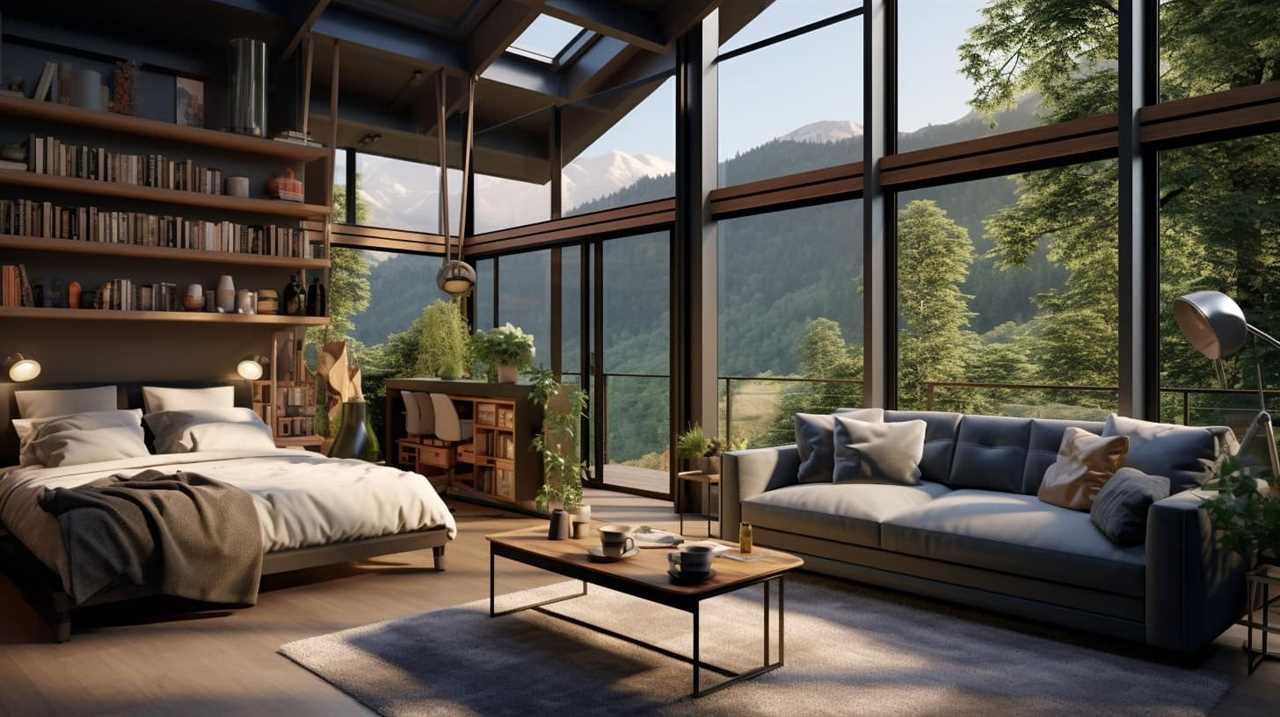
-
Hidden storage: Look for furniture pieces that double as storage units, such as ottomans with hidden compartments or beds with built-in drawers. Utilize the space under your stairs or install wall cabinets that can be easily concealed behind artwork or mirrors.
-
Creative shelving: Opt for floating shelves or wall-mounted racks to save floor space. Use vertical space efficiently by installing shelves above doorways or in high corners. Consider using adjustable shelves that can be customized to accommodate different items.
-
Multipurpose furniture: Invest in furniture that serves multiple functions, like a coffee table with built-in storage or a dining table that can be extended or folded when not in use. Choose pieces that can be easily moved or rearranged to adapt to different needs.
Utilizing Vertical Space for Optimal Efficiency
We frequently use vertical space in our tiny house to optimize efficiency and create a more functional living environment. One way we maximize our vertical space is through vertical gardening. By utilizing wall-mounted planters and hanging baskets, we can grow herbs, flowers, and even small vegetables, bringing a touch of nature indoors while saving valuable floor space.
Another effective strategy we employ is space-saving furniture arrangements. We’ve carefully chosen furniture pieces that can be folded, stacked, or hung when not in use, allowing us to create multipurpose areas that adapt to our changing needs. These smart furniture solutions not only save space but also add versatility and style to our tiny house.
Now, let’s explore some stylish small kitchen design ideas that further enhance our compact living space.
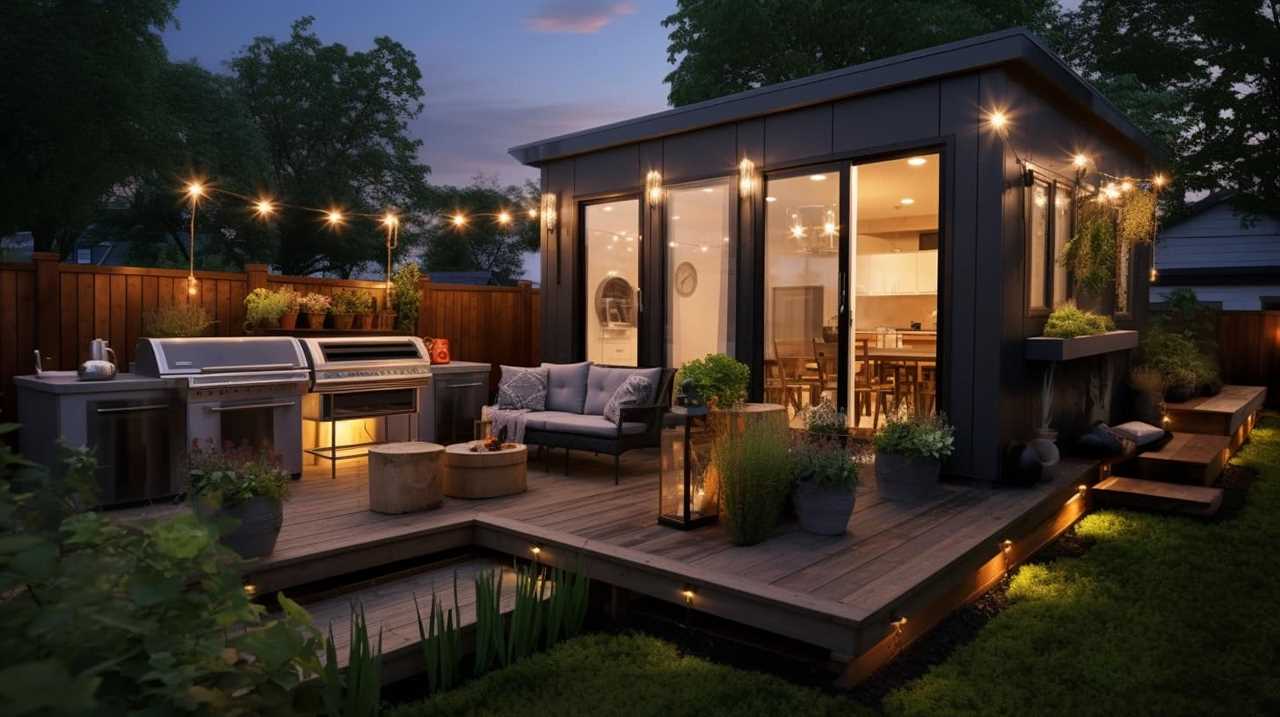
Stylish Small Kitchen Design Ideas
One of our favorite stylish small kitchen design ideas is to incorporate a sleek and compact island with built-in storage and seating. Not only does it add a modern and elegant touch to the kitchen, but it also provides additional countertop space for meal preparation.
To make the most of limited space, consider these three compact appliance options: a slimline dishwasher that can easily fit under the sink, a compact refrigerator with a built-in freezer, and a space-saving combination microwave and oven.
Additionally, creative storage solutions are essential in small kitchens. Install floating shelves on the walls to display decorative items and free up counter space. Utilize the inside of cabinet doors by attaching hooks or magnetic strips for storing utensils and knives.
With these design ideas, you can create a stylish and functional kitchen even in the smallest of spaces.
Transforming Small Bathrooms Into Spa-Like Retreats
Creating a tranquil and rejuvenating oasis can be achieved by incorporating calming color schemes and utilizing space-saving storage solutions in small bathrooms.
When transforming a small bathroom into a spa-like retreat, it’s important to focus on creating a serene and luxurious atmosphere. Start by selecting a spa-like color palette, such as soft blues, earthy greens, or soothing neutrals. These colors can help create a sense of calm and relaxation.
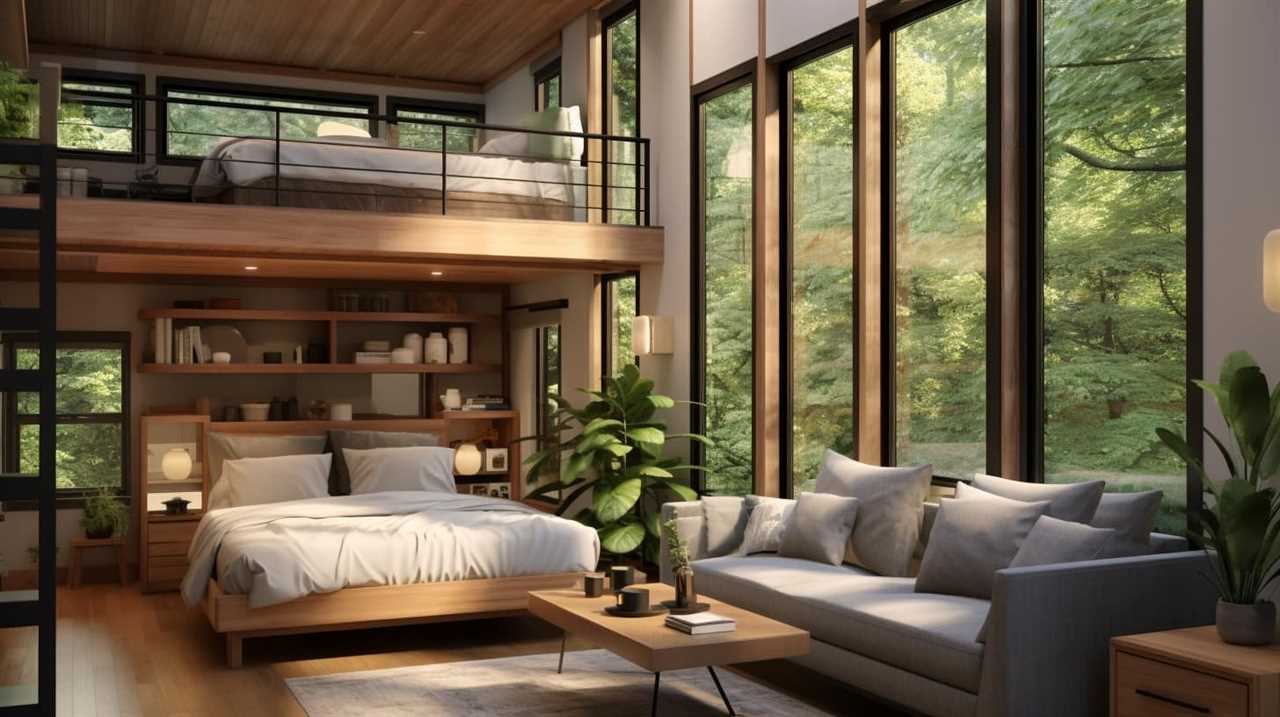
To enhance the spa-like ambiance, incorporate spa-like bathroom decor, such as plush towels, scented candles, and natural elements like plants. Additionally, using luxurious bath products, such as bath salts, essential oils, and high-quality soaps, can elevate the bathing experience.
With careful attention to detail and the right design choices, even the smallest of bathrooms can become a serene and luxurious sanctuary.
Outdoor Living in Tiny House Bliss
Let’s explore how we can make the most of our outdoor space in our tiny house to create a blissful and inviting living area. Outdoor living in a tiny house is all about maximizing every inch of space and creating a seamless connection between indoor and outdoor areas.
Here are three ideas to enhance your outdoor entertainment and tiny house landscaping:
-
Create a multi-functional outdoor space: Consider incorporating a foldable dining table that can double as a workspace or a small bar counter. Utilize vertical space by adding hanging planters or shelves for herbs and small potted plants.
-
Install a retractable awning or pergola: These additions provide shade and protection from the elements, allowing you to enjoy your outdoor space even on hot summer days or during light rain showers.
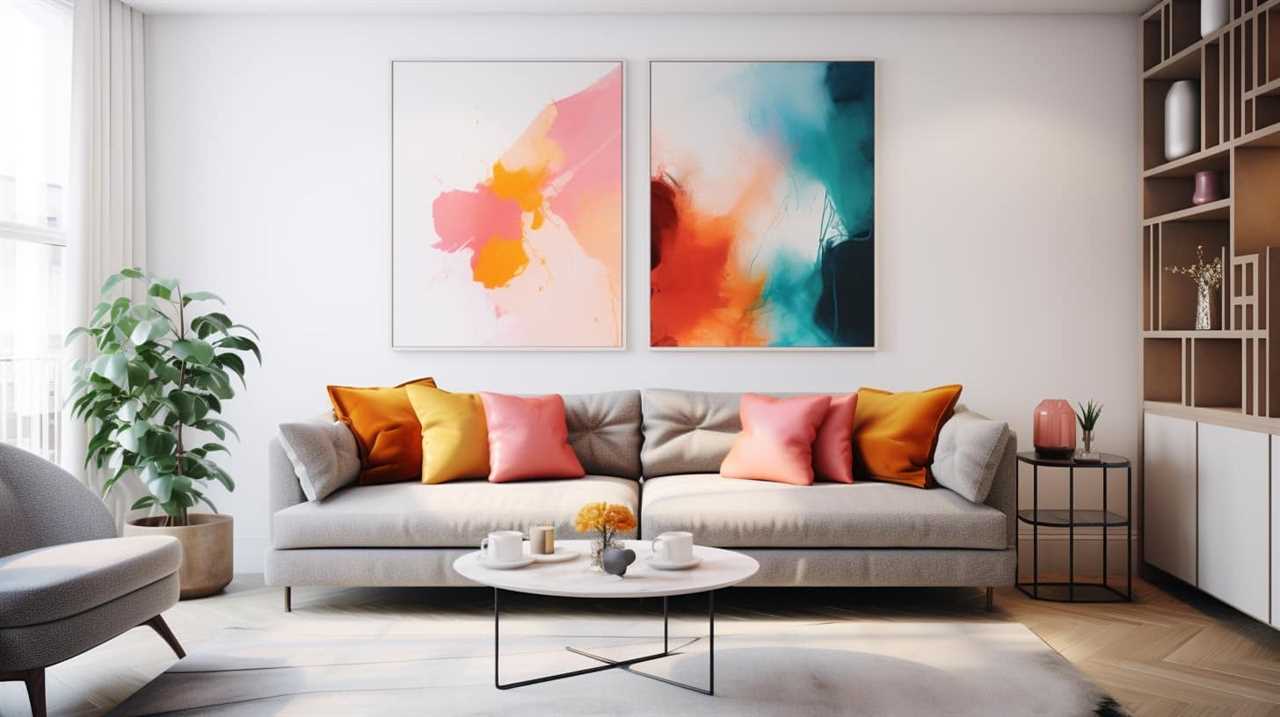
-
Design a cozy seating area: Opt for space-saving furniture like foldable chairs or benches that can be easily stored when not in use. Add outdoor cushions and throw pillows for comfort and style. Consider using string lights or lanterns to create a warm and inviting ambiance in the evenings.
Frequently Asked Questions
How Do I Handle Privacy in a Tiny House?
Privacy solutions in a tiny house can be challenging, but we’ve got you covered. Maximize storage by utilizing hidden compartments and multifunctional furniture. Hang curtains or install sliding doors to create separate spaces. Your privacy is important to us!
What Are Some Tips for Entertaining Guests in a Small Space?
When it comes to entertaining guests in a small space, we’ve found that maximizing seating options is key. For example, investing in small space furniture like foldable chairs or ottomans that double as seats can help accommodate more people without sacrificing comfort.
Can I Have Pets in a Tiny House?
Yes, we can have pets in a tiny house! We just need to consider pet-friendly amenities like built-in feeding stations and cozy nooks. And of course, we should think about pet care, such as providing enough exercise and creating a safe environment.
How Do I Deal With Laundry in a Tiny House?
When it comes to dealing with laundry in a tiny house, we’ve found that organization is key. We’ve discovered space-saving solutions that make doing laundry a breeze, allowing us to live comfortably in our small space.
What Are Some Creative Ways to Incorporate Artwork Into a Small Space?
Incorporating artwork into a small space can be challenging, but we’ve found some innovative display solutions and DIY art projects that allow us to showcase our creativity and add a personal touch to our tiny house.
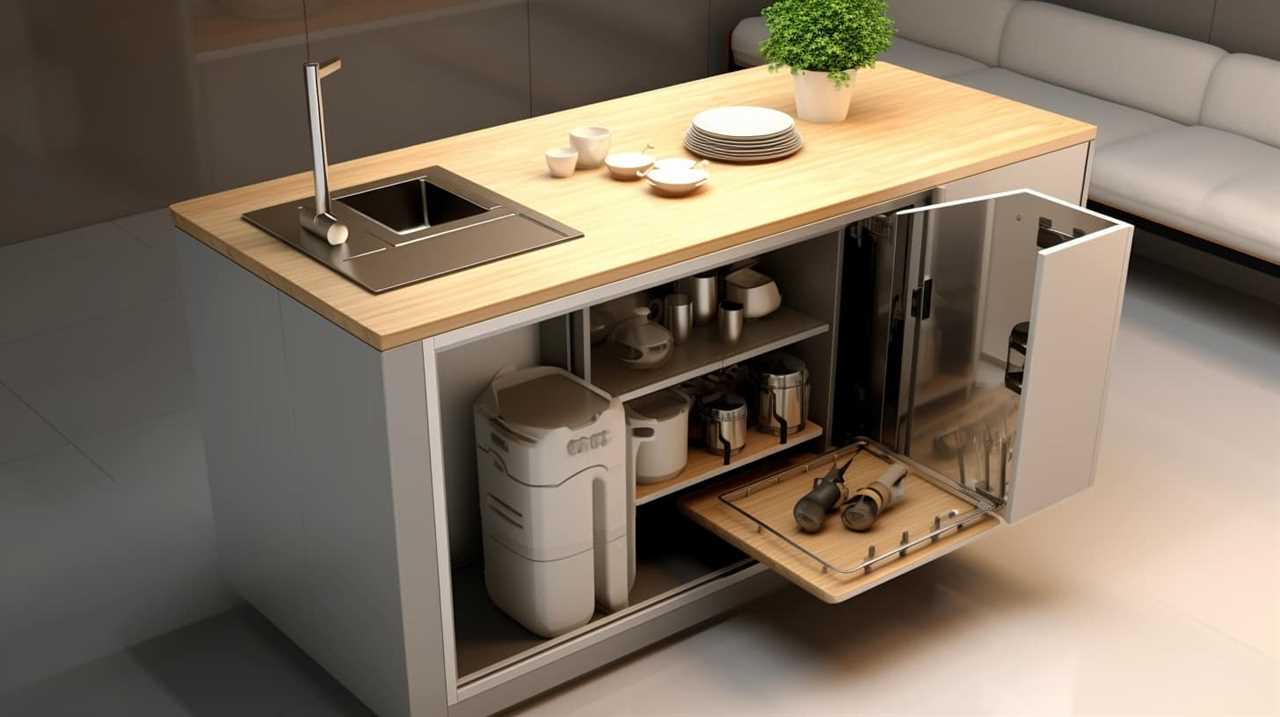
Conclusion
In the world of tiny house living, luxury and minimalism coexist harmoniously. We’ve discovered the art of maximizing limited space, organizing belongings effectively, and creating a luxurious ambiance through lighting.
We’ve mastered the art of maintaining cleanliness and elegance through indoor plant cultivation. By utilizing vertical space, we’ve achieved optimal efficiency. Our small kitchens are stylish and our bathrooms feel like spa-like retreats.
In the blissful outdoor living spaces of our tiny houses, we find true happiness.
I’m Theodore, and I love tiny houses. In fact, I’m the author of Tiny House 43, a book about tiny houses that are also tree houses. I think they’re magical places where imaginations can run wild and adventures are just waiting to happen.
While tree houses are often associated with childhood, they can be the perfect adult retreat. They offer a cozy space to relax and unwind, surrounded by nature. And since they’re typically built on stilts or raised platforms, they offer stunning views that traditional homes simply can’t match.
If you’re looking for a unique and romantic getaway, a tree house tiny house might just be the perfect option.
Tiny Houses
Tiny House Movement: The Unexpected Solution to Urban Planning Woes
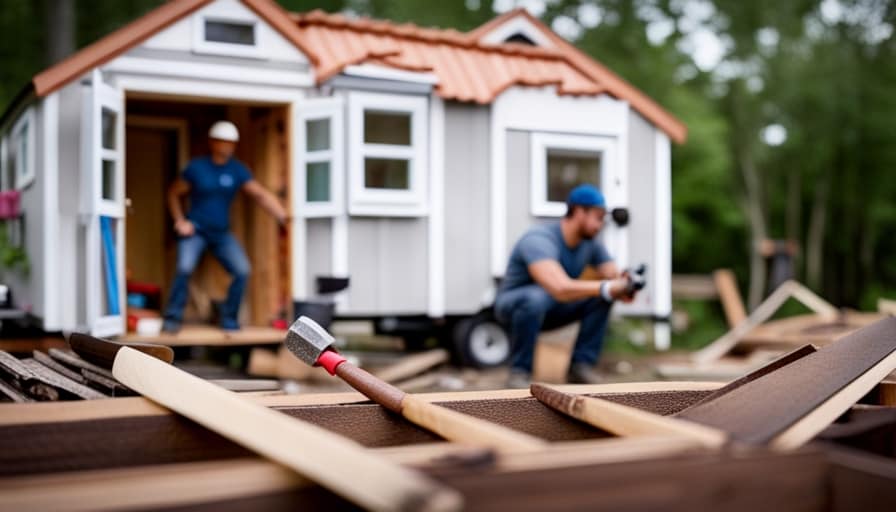
If you’ve ever considered if there’s a way to address the daunting issues of urban planning, consider exploring the tiny house movement.
We, as a community, have discovered an unexpected remedy to the woes of crowded cities and unaffordable housing. Through our collective efforts, we are transforming communities, challenging zoning laws, and building strong connections.
Join us as we delve into the grassroots origins, social impact, and advocacy organizations that drive this movement.
Together, we can serve others and create a better future.
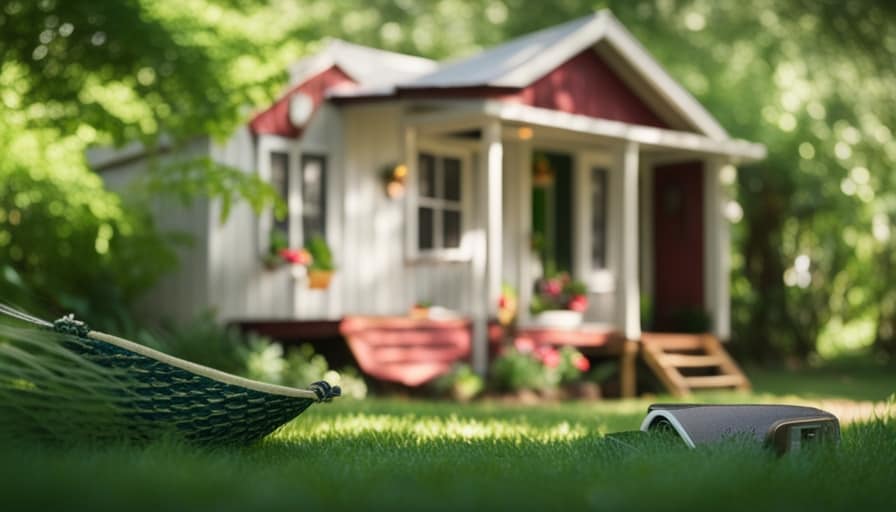
Key Takeaways
- The tiny house movement originated from a dissatisfaction with traditional housing and has evolved to include innovative designs and diverse architectural styles.
- Tiny homes have a social impact by providing affordable housing options, fostering a sense of community and connection among residents, and promoting sustainable living and community empowerment.
- Zoning laws present challenges for tiny house dwellers, including limited options for legal places to live, exclusionary minimum size requirements, lack of infrastructure, and neighborhood opposition.
- Advocacy organizations play a crucial role in driving the movement by promoting the benefits of tiny houses, raising awareness, influencing policy changes, and creating zoning ordinances.
Grassroots Origins: Tracing the Birth of the Tiny House Movement
We often hear about the Tiny House Movement and its grassroots origins, tracing the birth of this movement to passionate individuals who saw the need for a simpler and more sustainable way of living.
The evolution of the Tiny House Movement can be attributed to a growing dissatisfaction with the excessive consumption and environmental impact associated with traditional housing. As people began to question the status quo, they sought alternative solutions that aligned with their values of minimalism and sustainability.
These early pioneers experimented with compact living spaces, exploring innovative designs that maximized functionality and minimized waste. Through trial and error, they refined the concept of tiny homes, creating a movement that now encompasses a diverse range of architectural styles and lifestyles.
This evolution of the Tiny House Movement hasn’t only transformed the way we think about housing, but it has also had a profound impact on communities across the country.
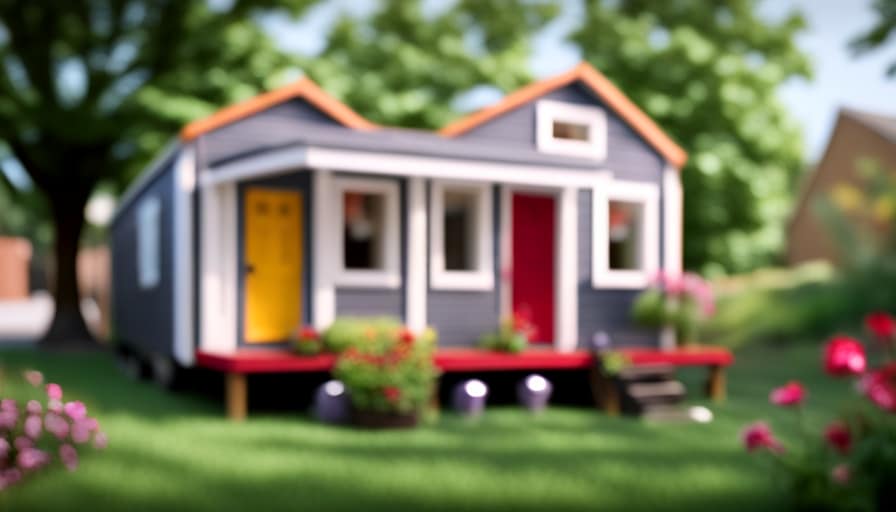
Social Impact: How Tiny Homes Are Transforming Communities
With their small size and flexible nature, tiny homes aren’t only providing affordable housing options, but they’re also fostering a sense of community and connection among residents. These homes encourage a shift towards sustainable living and community empowerment.
By living in close proximity to one another, tiny house residents are able to form strong bonds and support systems. They often collaborate on shared resources, such as community gardens or co-working spaces, which not only promote sustainability but also enhance social interaction. Furthermore, the compact size of these homes encourages residents to spend more time outdoors, engaging with their neighbors and participating in communal activities.
Zoning Law Struggles: Navigating the Challenges for Tiny House Dwellers
Many tiny house dwellers encounter numerous challenges when navigating the restrictive zoning laws and regulations. These legal barriers often hinder their ability to find suitable locations for their tiny homes and can be a major obstacle in achieving affordable housing. Some of the key struggles faced by tiny house dwellers include:
- Limited zoning options: Many areas have strict regulations that don’t allow for the placement of tiny houses, making it difficult for individuals to find legal places to live.
- Minimum size requirements: Some zoning laws require minimum square footage for residential properties, which can exclude tiny houses that are designed to be compact and efficient.
- Lack of infrastructure: Zoning laws may require certain infrastructure, such as utilities and sewage systems, that may not be feasible or affordable for tiny house dwellers.
- Neighborhood opposition: Some communities may have resistance to tiny houses, viewing them as a detriment to property values or as a potential source of overcrowding.
- Building codes: Tiny houses often face challenges in meeting building codes, which may be designed for larger, traditional homes and can be costly to comply with.
Despite these obstacles, advocacy organizations have played a crucial role in supporting the tiny house movement and fighting for changes in zoning laws. These organizations have been the driving force behind the movement, pushing for legislative changes and raising awareness about the benefits of tiny houses.
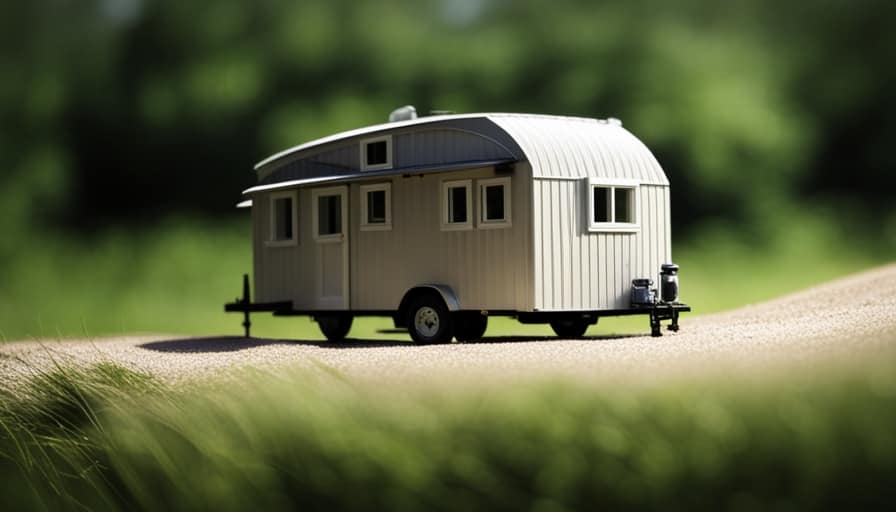
Advocacy Organizations: The Driving Force Behind the Movement
Although advocacy organizations have faced challenges, they continue to be the driving force behind the tiny house movement. These organizations play a crucial role in promoting the benefits of tiny houses and advocating for policy changes that support their development.
Through their advocacy strategies, such as community engagement, education, and lobbying, these organizations are able to raise awareness about the advantages of tiny houses and garner support from both the public and policymakers. They’ve been successful in influencing policy at the local, state, and even national levels, resulting in the creation of zoning ordinances that allow for the construction of tiny houses and the development of tiny house communities.
Advocacy organizations are instrumental in shaping the future of the tiny house movement and ensuring its continued growth and success.
Community Living: Building Strong Connections in the Tiny House Movement
We have found that community living fosters strong connections within the tiny house movement. People who choose to live in tiny houses often prioritize building relationships and forming a sense of community. This is especially true when they share a common space or live in close proximity to one another.
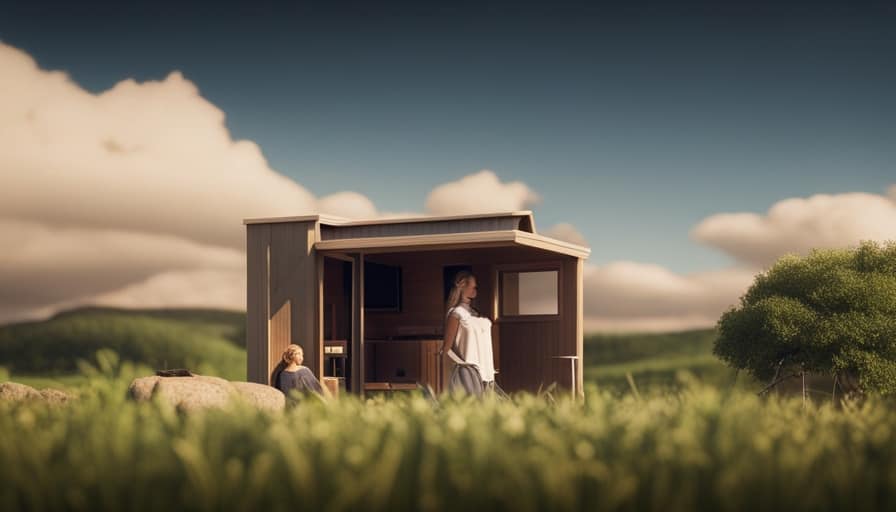
Community living in the tiny house movement offers numerous benefits, including:
-
Increased social support: Living in a close-knit community allows individuals to rely on one another for emotional support, creating a strong sense of belonging.
-
Collaboration and shared resources: Community members often collaborate on projects, sharing tools, knowledge, and skills, which leads to a more sustainable and efficient lifestyle.
-
Reduced isolation: Community living helps combat the isolation that can come with living in a tiny house, as there are always neighbors nearby to interact with.
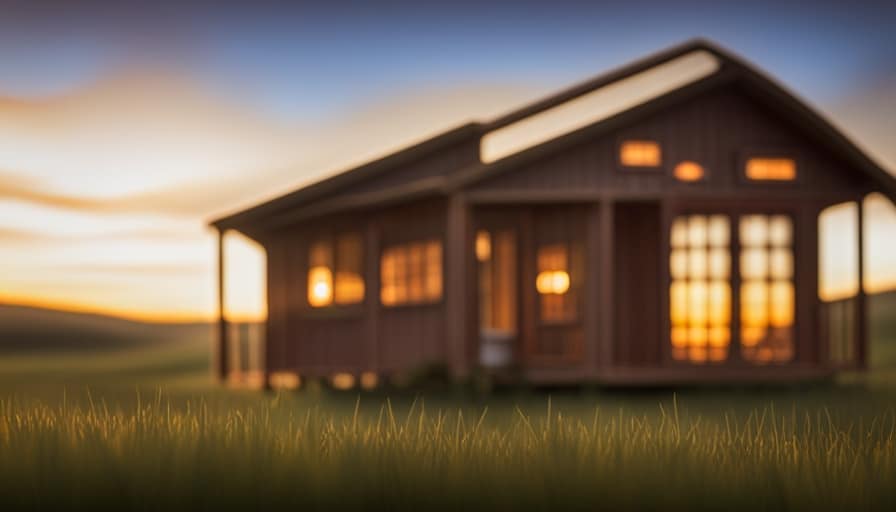
-
Collective problem-solving: Living in a community provides opportunities for collective problem-solving and decision-making, leading to more inclusive and effective solutions.
-
Enhanced well-being: The relationships formed in a community setting contribute to improved mental and emotional well-being, creating a supportive environment where everyone feels valued and connected.
Community living in the tiny house movement not only offers practical benefits such as shared resources but also creates a sense of belonging and strong connections among its members.
Frequently Asked Questions
How Did the Tiny House Movement Gain Popularity and Support From the General Public?
The tiny house movement gained popularity and general support due to its appeal to those seeking a simpler, more sustainable lifestyle. Its focus on minimalism, affordability, and environmental consciousness resonated with the public, leading to its widespread acceptance.
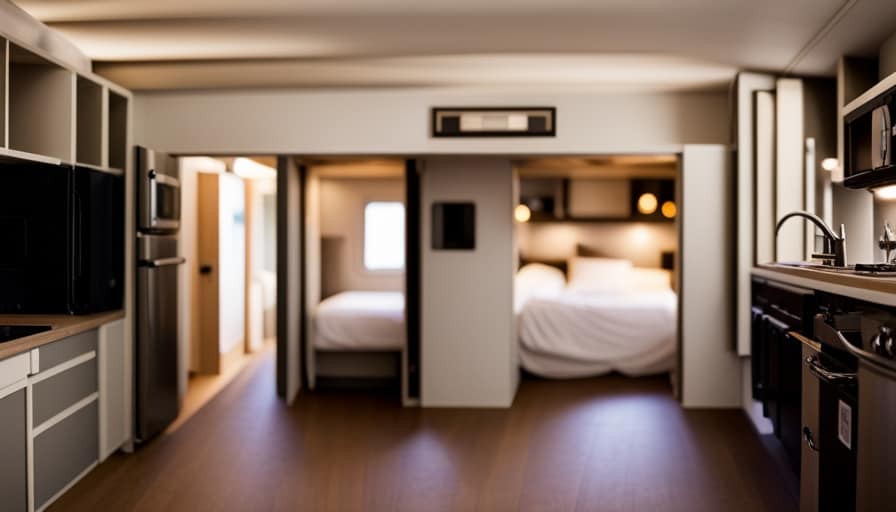
What Are Some of the Positive Impacts That the Tiny House Movement Has Had on Communities?
The tiny house movement has had numerous positive impacts on communities. It has fostered social cohesion by promoting shared spaces and communal living, creating a sense of belonging and connection among residents.
What Are the Main Challenges Faced by Individuals Living in Tiny Houses in Terms of Zoning Laws?
Zoning law restrictions and difficulties obtaining permits are major challenges faced by individuals living in tiny houses. It is frustrating to navigate through the complex regulations and bureaucracy, hindering the growth of the tiny house movement.
Which Organizations Have Been Instrumental in Advocating for the Tiny House Movement and What Initiatives Have They Undertaken?
Advocacy organizations play a crucial role in promoting the tiny house movement. Through various initiatives, they aim to raise awareness, influence policy changes, and provide resources for individuals interested in living in tiny houses.
How Do Tiny House Communities Foster a Sense of Connection and Support Among Their Residents?
Living in tiny house communities fosters a strong sense of community and support among residents. By sharing resources and working together, we create a supportive environment where everyone can thrive and find connection with others.
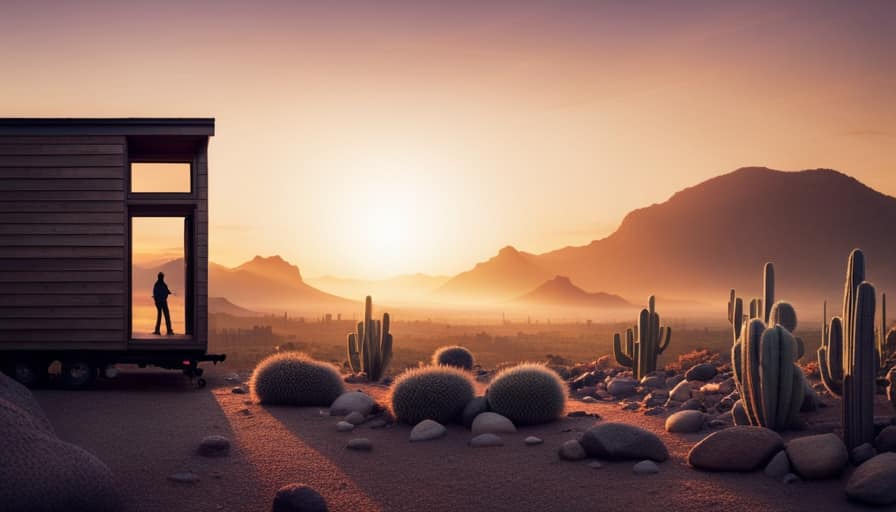
Conclusion
In conclusion, the tiny house movement has emerged as an unexpected solution to urban planning woes. By tracing its grassroots origins, we can see how these small dwellings are transforming communities and building strong connections.
However, navigating zoning laws remains a struggle for tiny house dwellers. Despite these challenges, advocacy organizations continue to drive the movement forward.
Through the juxtaposition of individual autonomy and community living, the tiny house movement offers a unique and promising approach to address urban planning issues.
I’m Theodore, and I love tiny houses. In fact, I’m the author of Tiny House 43, a book about tiny houses that are also tree houses. I think they’re magical places where imaginations can run wild and adventures are just waiting to happen.
While tree houses are often associated with childhood, they can be the perfect adult retreat. They offer a cozy space to relax and unwind, surrounded by nature. And since they’re typically built on stilts or raised platforms, they offer stunning views that traditional homes simply can’t match.
If you’re looking for a unique and romantic getaway, a tree house tiny house might just be the perfect option.
-

 Beginners Guides2 weeks ago
Beginners Guides2 weeks agoHow To Buy A Tesla Tiny House
-

 Energy Efficiency2 months ago
Energy Efficiency2 months agoBest Tiny Homes For Cold Climates
-

 Beginners Guides1 week ago
Beginners Guides1 week agoTiny House Nation Where Are They Now Stephanie
-

 Tiny House Resources (e.g., legalities, cost, insurance, FAQs)2 months ago
Tiny House Resources (e.g., legalities, cost, insurance, FAQs)2 months agoDo Tiny Homes Need Planning Permission?
-

 Beginners Guides3 weeks ago
Beginners Guides3 weeks agoFrom The Show Tiny House Nation How Many Keep Their Tiny House?
-

 Beginners Guides2 months ago
Beginners Guides2 months agoUsing a Climbing Net For Treehouse Construction
-

 Beginners Guides2 months ago
Beginners Guides2 months agoHow to Build a Treehouse Without Drilling Into the Tree
-

 Beginners Guides3 weeks ago
Beginners Guides3 weeks agoTiny House Nation Who Pays For The Houses









